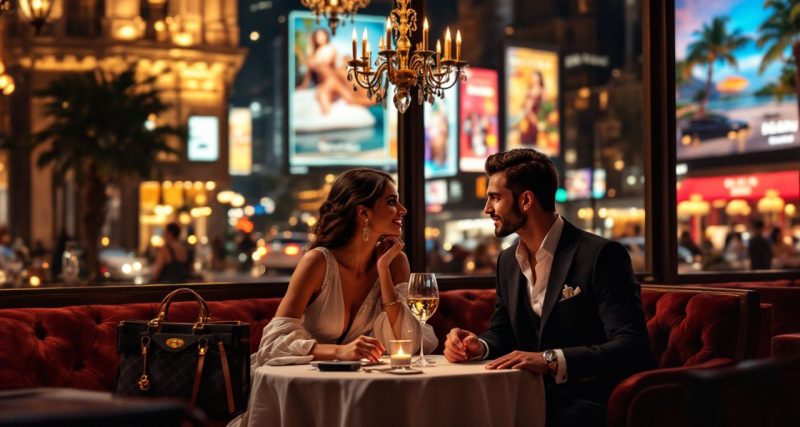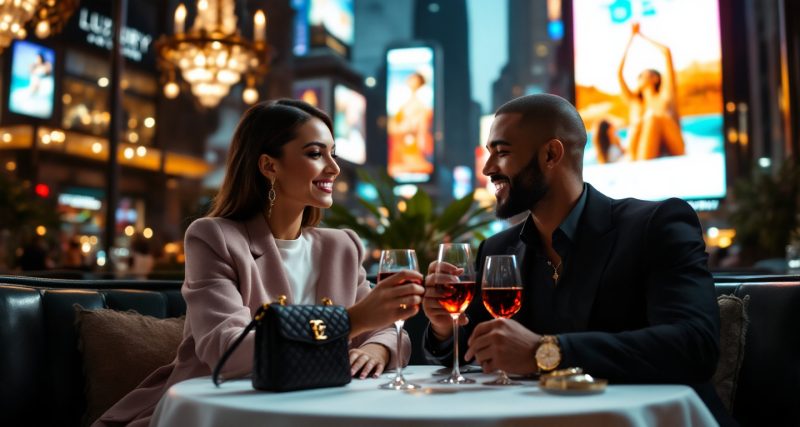
Research by Q. Chen et al. explores how women wield luxury goods as shields rather than magnets in the dating scene. This is called the “mate screening motive.” It says, “I’ve got standards; entry costs apply.” When this motive kicks in, women reach for items with logos and price tags that can’t be ignored. Studies show that this behavior spikes when external tools (like dating apps with filters) aren’t an option, leaving the luxury tag as the most immediate screener.
In one study, participants in the mate screening condition showed a significantly stronger preference for luxury brands when the motive was strong compared to when it was weak. In numbers: 4.47 versus 3.72 on a consumer preference scale (Mstrong = 4.47; Mweak = 3.72). This suggests a direct link between the pressure to deter and the choice to splurge.
Aspirational Marketing and Non-Traditional Relationships
Luxury marketing excels at creating dreams people want to live in. Platforms focused on elite dating embody this concept in the relationship space. These services cater to people who know their preferences and aren’t shy about pursuing connections that align with their lifestyle. The aspirational allure is the same—luxury brands craft their image to make you feel like being part of their world means you’ve “arrived.”
From personalized matchmaking to unique social circles, brands and services alike fuel the idea that exclusivity defines desirability. Relationships formed within these contexts reflect a clear sense of intentionality—choices rooted in clear expectations rather than settling for what’s convenient or expected.
High Prices, Higher Standards
Luxury brands thrive on exclusivity, and their strategies seamlessly translate to the dating market. The message is clear: scarcity equals value. Limited-edition products, steep prices, and exclusive events create an emporium that promises to filter quality through spending power. Women, already assessing financial markers in dating, lean into these symbols to signal their own expectations. It’s a consumer-driven audition process, with the bag as the resume.
But the game shifts when the dating pool levels up. When mate quality is high or external screening tools are available, the perceived need for luxury signaling fades. It’s like having filters on a dating app—they save time and cut costs.
Status Seekers and Social Sorting

Aspirational consumers, particularly those chasing status, make up a major slice of the luxury market. This group, largely under 35, invests in high-end fashion not just for quality, but for what it broadcasts: belonging to a higher social tier. Women in this category use luxury goods as part of their dating arsenal, leaning into the cultural shorthand that equates brand names with standards.
Unlike men, who use luxury goods to attract attention by signaling wealth and dominance, women use the same goods to filter and deter. It’s less about “look at me” and more about “don’t even try.” This creates parallel yet distinct relationships between gender and high-end consumer behavior in romantic contexts.
When the Script Changes
There’s nuance in how mate screening operates. While handbags and accessories do the talking in many romantic settings, they go quiet when other tools or circumstances take over. Filters on dating apps, for instance, allow women to vet matches without needing external signals like fashion or accessories. Similarly, when the pool of potential dates is already vetted for quality—say, at singles’ events with high barriers to entry—luxury starts to lose its screening edge.
Interestingly, a non-mating control condition confirmed that this behavior isn’t simply a reaction to annoyance from lower-quality suitors. It centers on the specific intention to attract the right match and screen out the wrong ones. The motive itself, not background factors, drives the consumption.
Economic Criteria on the Radar
Regardless of personal income, a woman’s assessment of a partner’s finances remains foundational. This aligns well with the idea of luxury as a signaling tool: it’s not purely about splurging, but what the splurge communicates. The designer tote in question says, “Your resources need to match or exceed mine.” Financial capability, as steady research shows, ranks high on the checklist.
